You can grow a mango tree from a seed in a pot to keep it small and manageable (say 8 – 10 feet), or you can plant it in the ground for a larger tree if you live in U.S. Department of Agriculture plant hardiness zones 10b through 11.
Either way, you’ll get to enjoy this juicy and exotic fruit year after year!
Items Needed
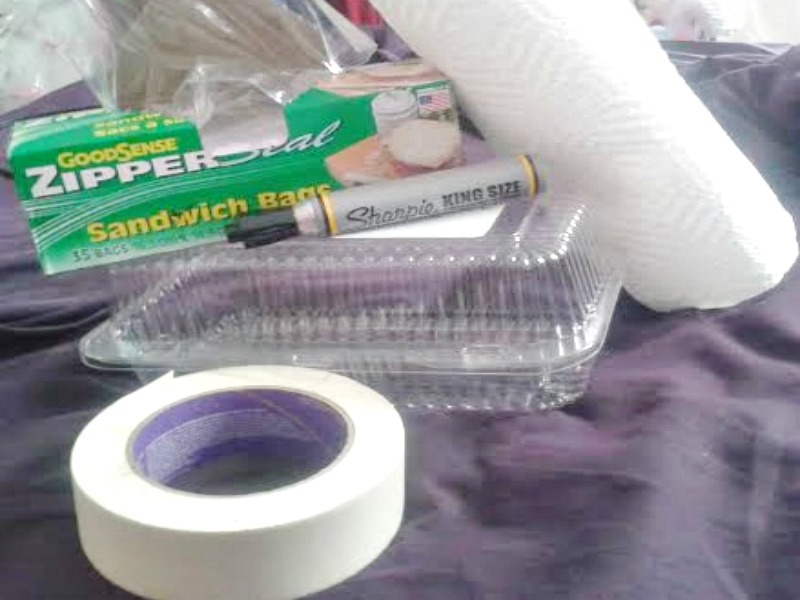
Dry mango husk with the seed inside, a dull knife, paper towel, sandwich bag, plastic clam shell container, marker
Step 1
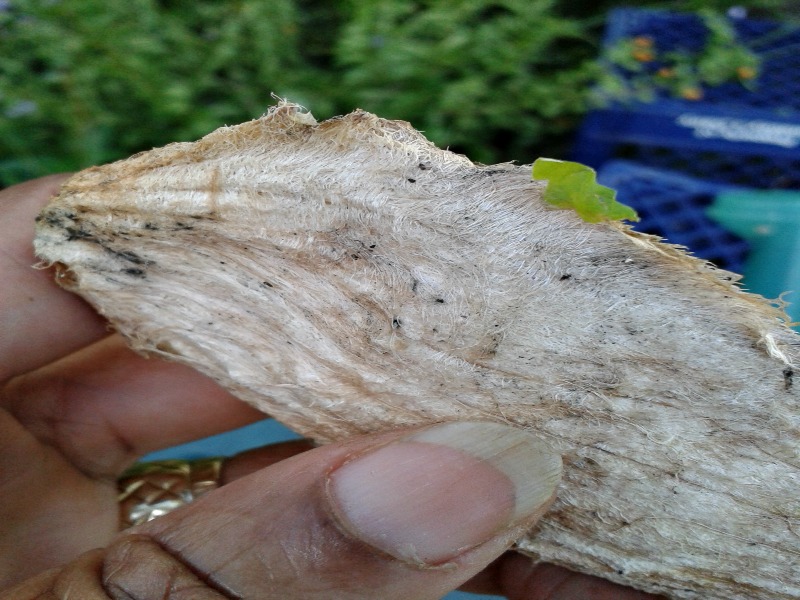 Once you have removed as much of the flesh from the mango husk, scrape away the hairs with a knife and set it in the sun for 1-2 to dry out.
Once you have removed as much of the flesh from the mango husk, scrape away the hairs with a knife and set it in the sun for 1-2 to dry out.
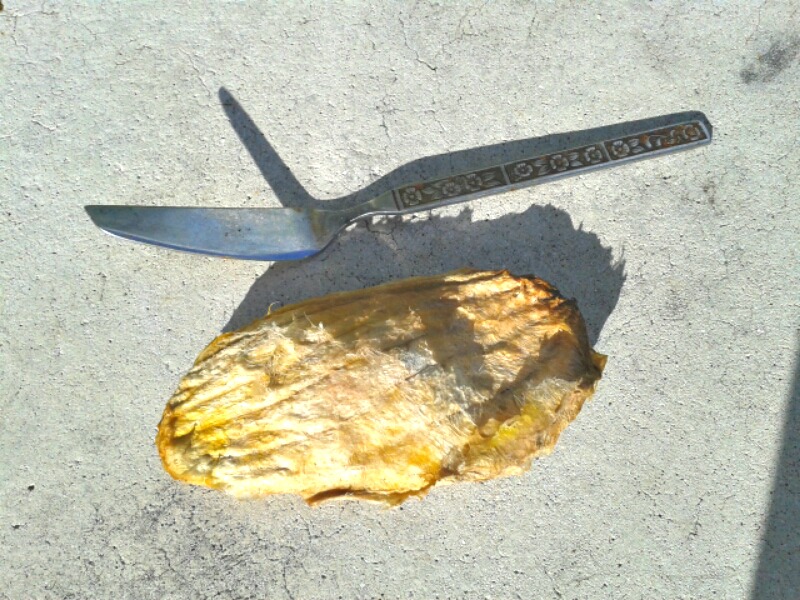 Turn the husk over once one side is completely dry.
Turn the husk over once one side is completely dry.
Step 2
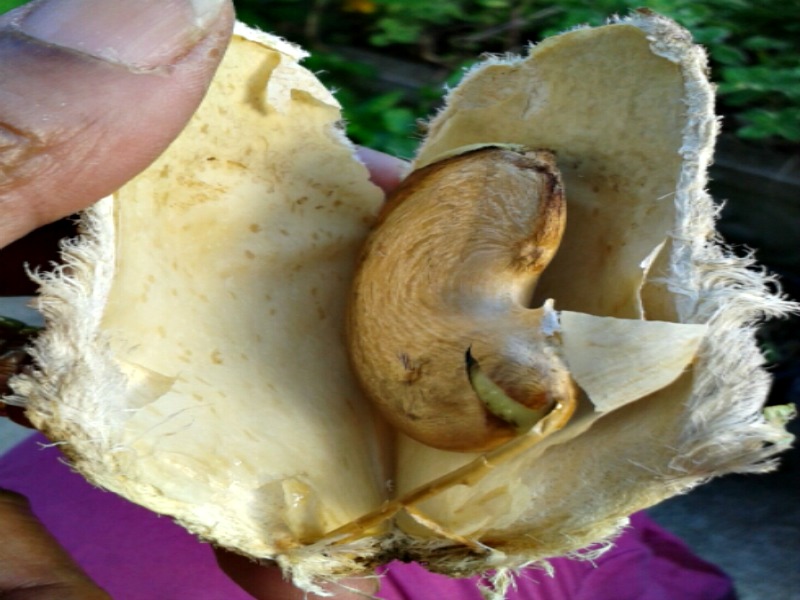 Use a dull knife to carefully open the seed on the round end careful not to damage the seed. Gently break open the husk with your bare hands.
Use a dull knife to carefully open the seed on the round end careful not to damage the seed. Gently break open the husk with your bare hands.
Step 3
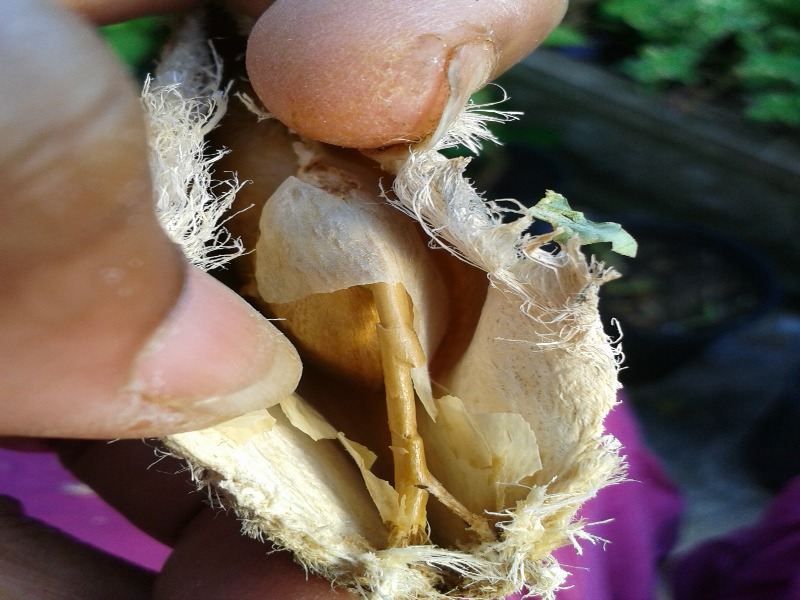 Once you have carefully opened the husk, it is alright to detach the umbilical cord attached to the bean shaped seed from the husk.
Once you have carefully opened the husk, it is alright to detach the umbilical cord attached to the bean shaped seed from the husk.
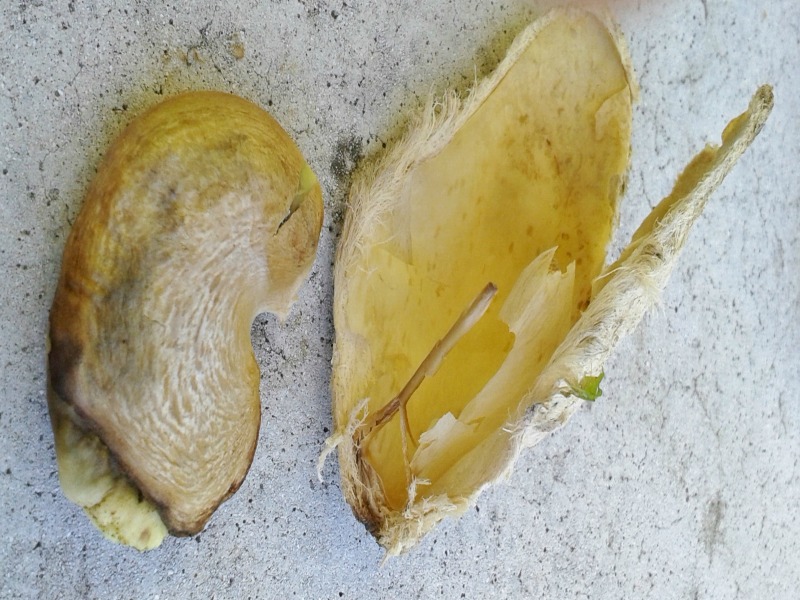 The seed inside should look tan and fresh like this
The seed inside should look tan and fresh like this
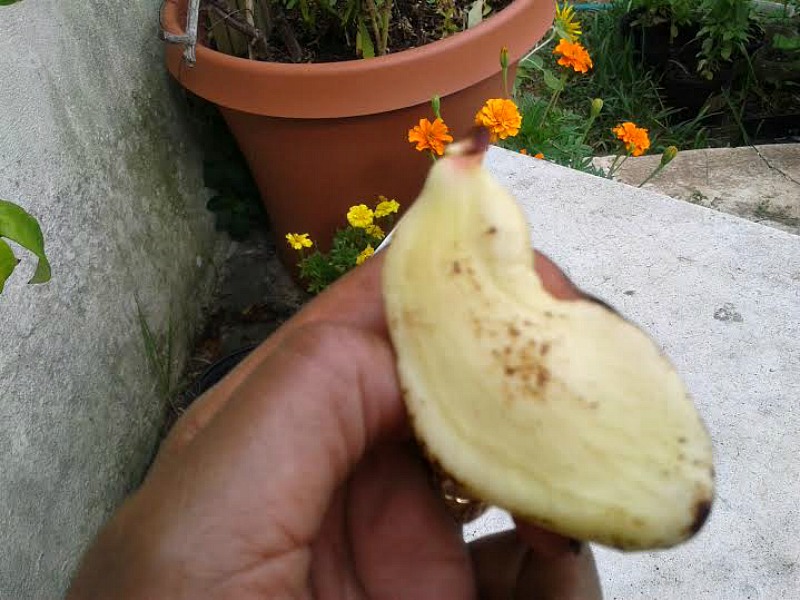 and this
and this
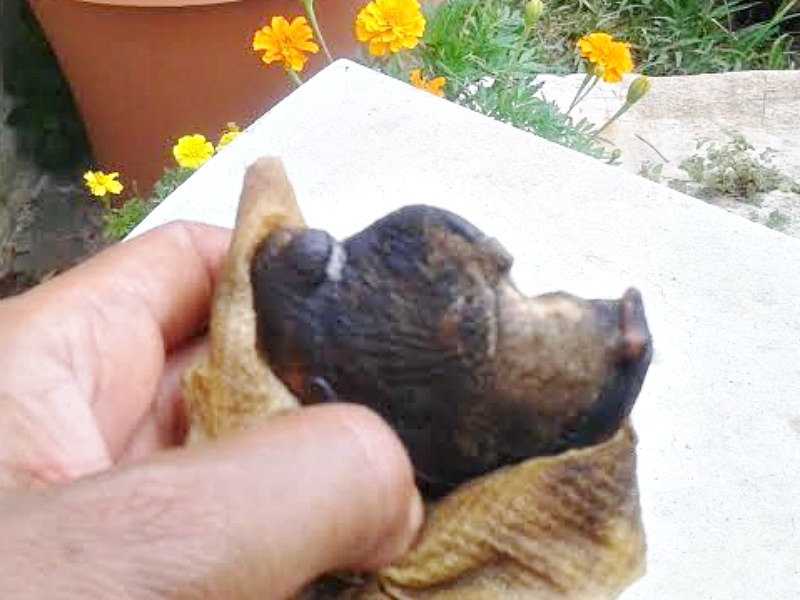 not like this.
not like this.
Do not remove the skin from the seed if it does not easily come off to the touch.
Step 4
 Wet a sheet of a paper towel with water; not too damp so as not to cause rot.
Wet a sheet of a paper towel with water; not too damp so as not to cause rot.
 Squeeze it and wrap up the seed as shown.
Squeeze it and wrap up the seed as shown.
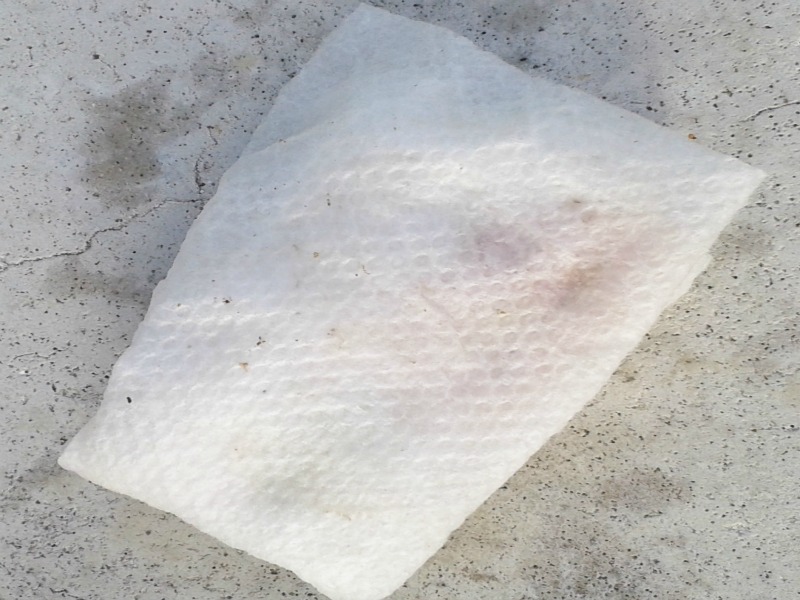
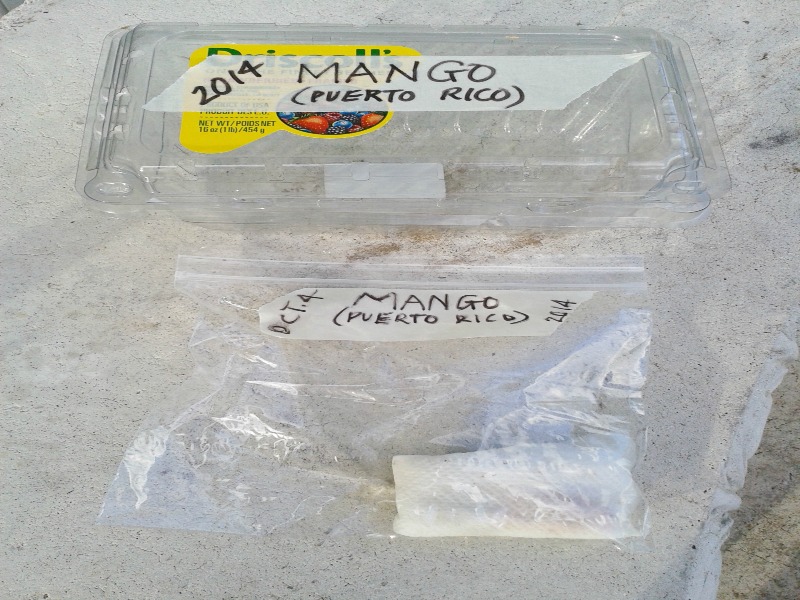 Place the wrapped seed in a sandwich bag and seal it tightly then place the sandwich bag inside a plastic fruit container. Be sure to label and date your sandwich bag and container.
Place the wrapped seed in a sandwich bag and seal it tightly then place the sandwich bag inside a plastic fruit container. Be sure to label and date your sandwich bag and container.
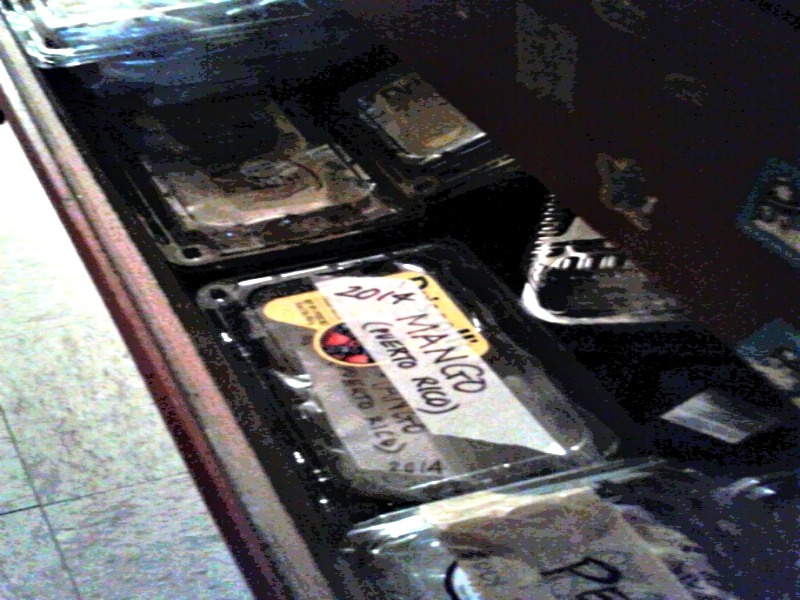 The container becomes your portable greenhouse which you then place inside a dark drawer or any dark place where it would not be disturbed.
The container becomes your portable greenhouse which you then place inside a dark drawer or any dark place where it would not be disturbed.
Check your seeds once daily to ensure it remains moist not wet.
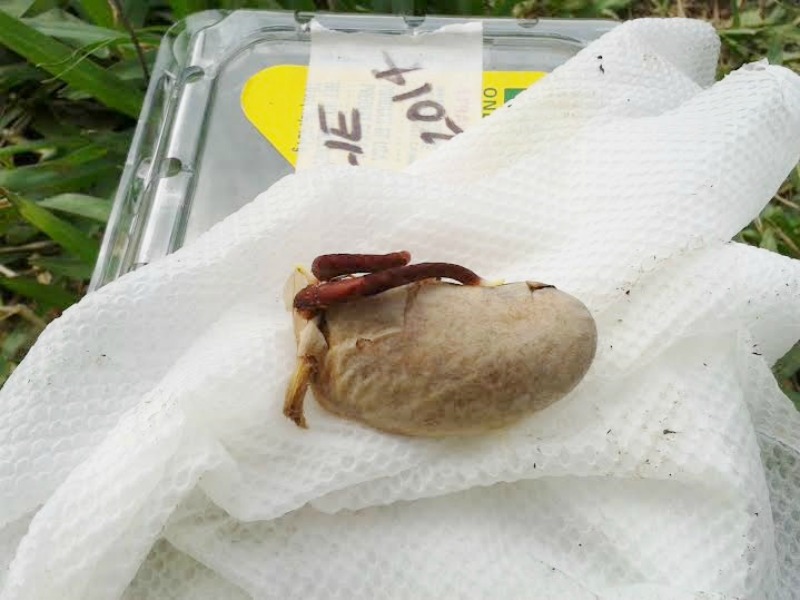 1 week in drawer
1 week in drawer
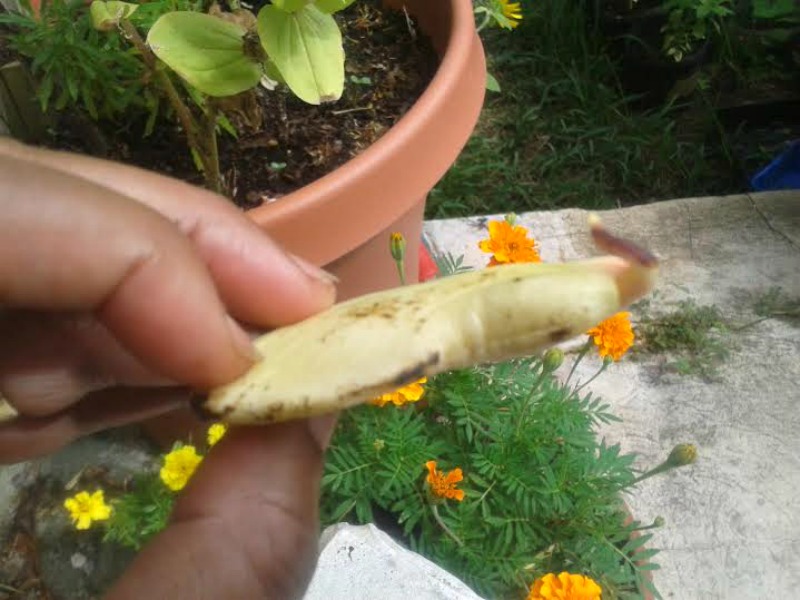 Ready to plant
Ready to plant
Planting your rooted mango seed
You will need:
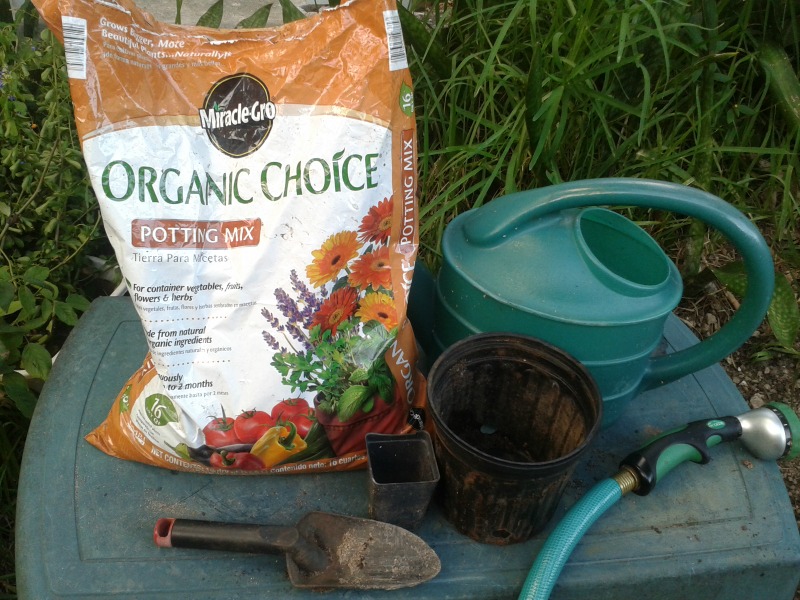 Fertilized, well drained potting soil, one gallon pot or larger for your seed, water.
Fertilized, well drained potting soil, one gallon pot or larger for your seed, water.
The mango seedling is very vulnerable in its early stages so it is best to initially plant your seed in a pot so you can control the temperature exposure.
Step 5
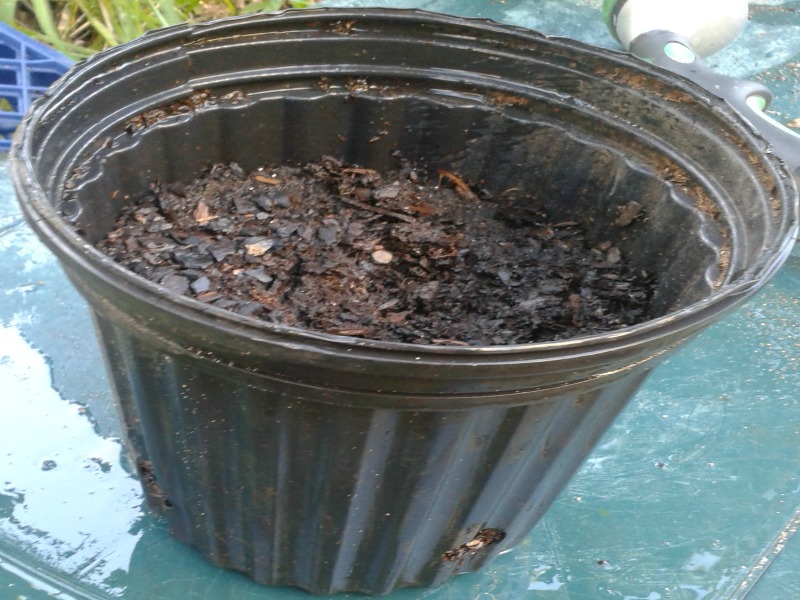 Fill your pot 2/3 with fertilized potting soil that drains well
Fill your pot 2/3 with fertilized potting soil that drains well
 then soak the soil with water.
then soak the soil with water.
Step 6
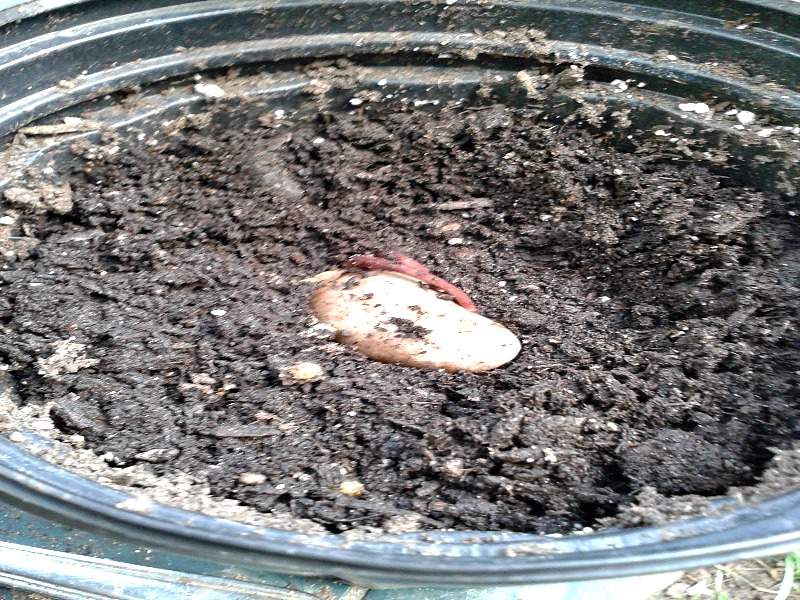 After the water drains adequately, place the mango seed, flat side down and gently cover with about 1/8 inch of soil.
After the water drains adequately, place the mango seed, flat side down and gently cover with about 1/8 inch of soil.
Press down lightly. Always be aware of being gentle and careful when handling your seed as you do not want to break off any of the delicate roots or new growth on the seed.
Place the pot outside in partial sun when there is no chance of frost.
Stages of Growth
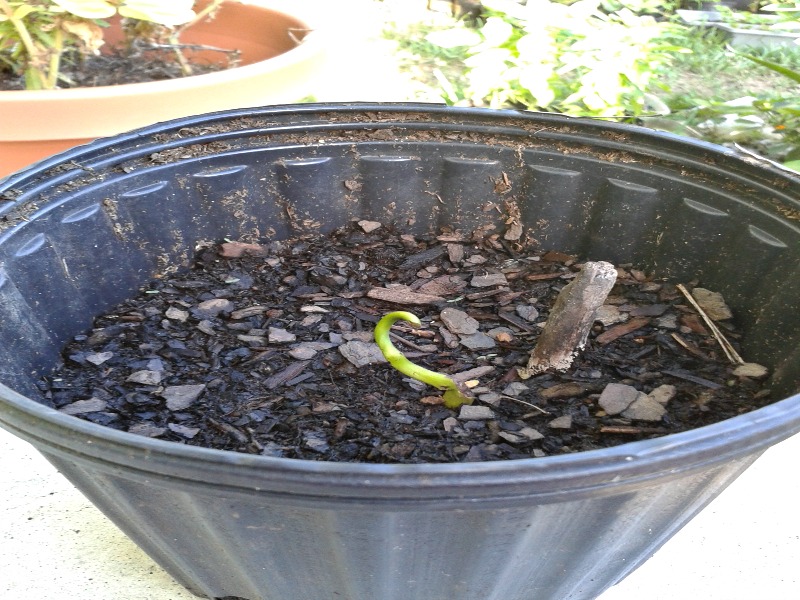 2 weeks
2 weeks
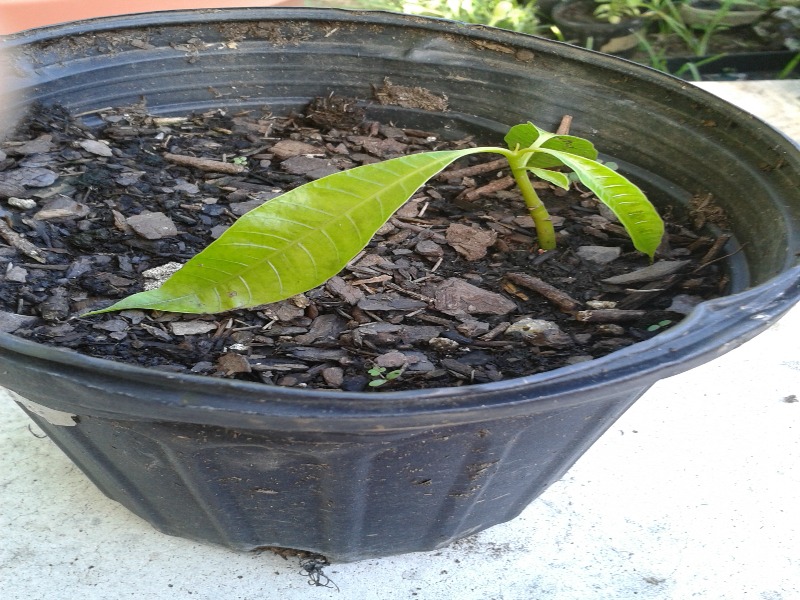 5 weeks
5 weeks
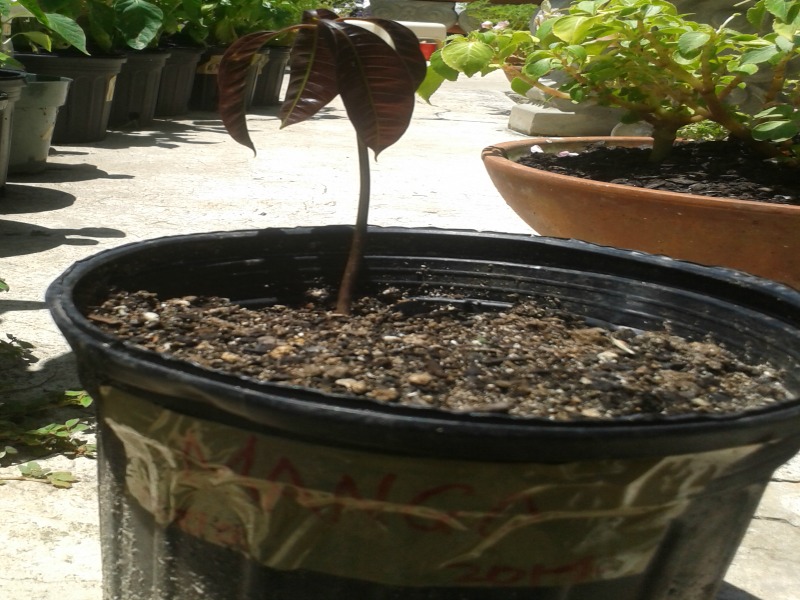 16 weeks
16 weeks
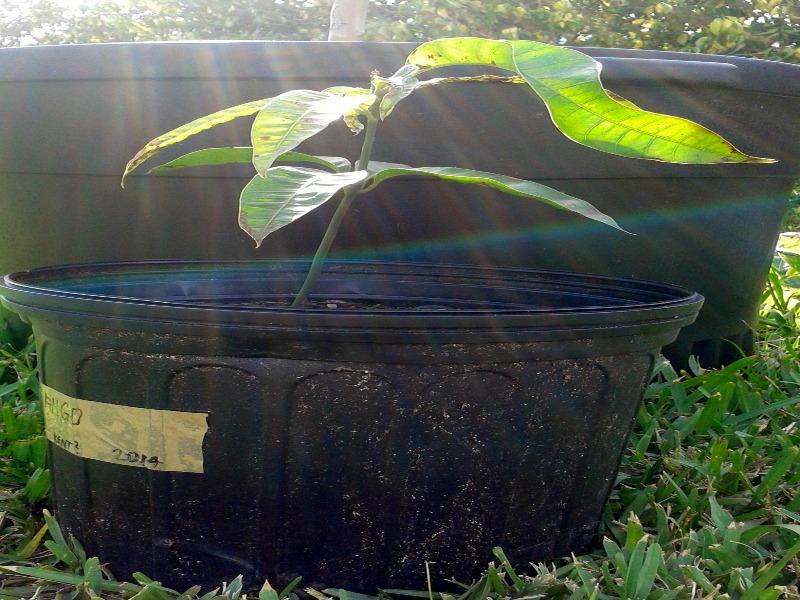 24 weeks
24 weeks
By two to three months, your mango seedling should be able to endure full sun. It does not need the daily nurturing which is necessary for the earlier stages.
Some seedling leaves are purple while others are bright green.
It takes at least 5 to 8 years for a mango tree planted from seed to bear fruit while the grafted ones take 3 to 4 years to fruit.
Seedling mango trees grow much bigger and stronger than the nursery trees and have an indestructible root system. They are slow to reach maturity but worth the wait.
About the Author
I am from beautiful Bermuda born and raised. I’m an avid gardener and I intend to sell my organic fruit trees (grown from seed) and tropical plants right from my small yard. I have traveled the world as an opera singer and now I teach here in Bermuda as a voice teacher and coach. I’ve been married for almost 45 years and I have three children and four grandchildren.
What happens if my seed turns black while germinating in the paper towel with green growth too?
Listala,
I guess it depends on how much mold is on them. Maybe let them air out for a day or so then wrap back up.
Thanks for the
education but i have a question.is it must to wrap the seed with a dump tissue paper until some roots appears or you can straight away plant the seed directly from husk in a pot?
Thomas,
As long as the soil is moist but not soaking wet that should work fine.
Which is flat side down? Both sides look flat. I have what looks like a seedling coming out of the wider end of the seed. Please help.
Maureen,
I’d say that either flat side should work equally well.
Hello Hello. I’ve managed to grow a seed in tapwater, so it has 4 leaves but each are different sizes because its in the windowsill facing south west so the leaves got differents amounts of sunlight. Will it be okay? Also if i wanted to repot it into soil how big of a pot do i need. the tap root is like 6.5 inches the last time i checked.
Hwinn,
Use a pot that is open on the bottom, even if you have to cut the bottom out, so the tap root and other roots can be air pruned. Place the pot on a wire rack so the air pruning can take place. You really don’t want to encourage that tap root.
I have 2 Mangos that I planted from seed. Both have forked where now there are 2 stems. The plant is about 1foot tall. Should I remove one stem?
Thanks
Ann,
You can and should if you want a single stem tree.
Ok Mr Mike
To “The Author”…the opera singer, voice teacher, coach with 3 kids and 4 g’kids…
I wish we could meet, but maybe in our next lives.
Growing a mango tree has just become a goal. Heretofore, I’ve saved those hairy little guys to use as fish in 3-D collages!!!
I sang, have 5 kids, 10 grands and 2 great grands. Plus, I’ve been to Bermuda! Rented one of those little scooters, put on my bathing suit and a long skirt and tootled around to my heart’s content.
You are very educated keep it on
To “The Author”…the opera singer, voice teacher, coach with 3 kids and 4 g’kids…
I wish we could meet, but maybe in our next lives.
Growing a mango tree has just become a goal. Heretofore, I’ve saved those hairy little guys to use as fish in 3-D collages!!!
I sang, have 5 kids, 10 grands and 2 great grands. Plus, I’ve been to Bermuda! Rented one of those little scooters, put on my bathing suit and a long skirt and tootled around to my heart’s content.
It should be noted that if you plant a mango seed because you loved the variety, you should not count on getting the same mango, if/when it ever reaches maturity, and produces fruit. Mangoes are F1 hybrids, grafted from a mother plant. The resultant offspring will never be what you planted. The only possible exceptions are stable varieties, which are usually some of the worst mangoes. At the point that you plant a mango seed, you are doing it for the love of growing.
Bucho, important information. Thank you!
OK, I don’t understand, will you please explain this. I’ve heard the same thing about other fruit trees, that if you plant the seeds from an apple or peach or whatever, you probably won’t get that same variety of fruit from the resulting tree. How can this be? Grafted or not, the seed will contain the DNA from the flower it was fertilized in, which would contain the DNA from the grafted branch, not the trunk (if it was grafted). Isn’t that what we want? Why would it not produce the same fruit that the seed was taken from?
Even taking cross pollination into account, that would happen at orchards as well, so I don’t see how that would cause a seed to have completely different DNA from the tree it was taken from. Plus, I only plan on having one mango tree indoors (which probably will never produce fruit anyway) but I’m just saying. I just enjoy growing plants. But I do want to understand this DNA thing. It doesn’t make sense to me and I am suspicious that it is disinformation being spread by the agriculture industry to discourage people from growing their own food, thereby keeping more customers and making more money.
Jennifer,
If you want a true clone of a tree that you have in your yard, a tree that will produce fruit identical what you are getting now, you have to propagate that tree by means of asexual reproduction. Cuttings, grafts or tissue culture. Growing from seed is sexual reproduction. The off spring, the resulting plant is not identical to either parent, but a combination of both parents. The DNA is not identical, but mixed. Similar, but not identical. If you have a child her DNA is similar to yours but not identical to yours.
Make sense?
If you grow seeds from a Honey Crisp apple you will not get honey crisp apple trees but you will get apple trees. The fruit that they bear could be very similar to honey crisp, very different from honey crisp, but not identical to honey crisp. I hope this helps.
only Polyembryonic mango grow true the seed. Mono Embryonic mango meaning one Embryo usually produce inferior fruit but all mango seedlings can be grafted to a mother plant to get the variety of fruit you like
Keep in mind that if you prune a mango, it can affect fruiting for a season or two. Once they are about 5-6 years old, they do like to be pruned in the middle to allow air circulation and to cut down on molds which affect fruit setting. Good luck!
Hi i like your site,
I have a manago that i have grown from seed it is about a half a meter in hight i would like to graft it but it is forked and i am unsure where to place the graft as it is forked very close to the ground can you PLEASE ADVISE ME GOD BLESS MANY THANKS DWGOULDING JP AUSTRALIA
Des,
You can pick the forked branch you like, make the graft, then remove the ungrafted fork. Typically this type of pruning is best done when the seedling is small.
Hi there. Before you do anything, fill you pot with good, fertilized soil and water thoroughly. Mind you I usually don’t water my mango trees very often and they are all thriving in their pots. I’m surprised it was too hot for your plant since it’s a tropical fruit tree. Just curious but where do you live?
Personally I would cut off the dead branch since it is now catching itself.
In the meantime you may find this link useful in the near future.
http://modernfarmer.com/2015/02/right-cut/
Hi there. In my experience dead branches should be removed from any type of tree. Be sure to replace the soil within the pot, fertilizer and water thoroughly once that’s done. I’m surprised your mango did not like the full sun as it is a tropical fruit tree. Where do you live lisa? By the way.. youmay find this link useful…. http://modernfarmer.com/2015/02/right-cut/
I have a mango tree that was started from a seed & has been in a pot for about 3 years. Recently it was out in the yard & got a little too much sun & I realized that there was a lot less soil in the pot too. I moved it into the shade by the house under the roof eave & it’s doing a lot better. New leaf growth & is healthier now. But, there is a lot of dead branch at the top of the plant, approximately 2 feet & I haven’t trimmed it off because I wasn’t sure how to do it & didn’t want to cause it any more grief. What should I do?
Hi there. In my experience all dead branches from any type of tree (especially fruit trees) should be removed.
Branches die off for a number of reasons including light deficiency, pest and disease damage, and root structure damage. A dead branch will at some point decay back to the parent stem and fall off. This is normally a slow process but can be quickened by high winds or extreme temperature. The main reason deadwooding is performed is safety. Situations that usually demand removal of deadwood is trees that overhang public roads, houses, public areas and gardens.
Another reason for deadwooding is amenity value, i.e. a tree with a large amount of deadwood throughout the crown looks more aesthetically pleasing with the deadwood removed. The physical practice of deadwooding can be carried out most of the year though not when the tree is coming into leaf. The deadwooding process speeds up the tree’s natural abscission process. It also reduces unwanted weight and wind resistance and can help overall balance.
Check out this link on how to prune fruit trees. You may find it helpful in the near future. http://modernfarmer.com/2015/02/right-cut/